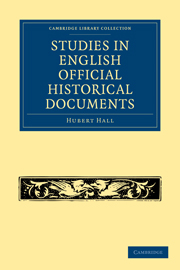Book contents
- Frontmatter
- PREFACE
- Contents
- ERRATA
- PART I THE SOURCES OF OFFICIAL HISTORICAL DOCUMENTS
- PART II THE DIPLOMATIC OF OFFICIAL HISTORICAL DOCUMENTS
- INTRODUCTION TO THE DIPLOMATIC STUDY OF OFFICIAL DOCUMENTS
- THE ANGLO-SAXON CHARTERS
- ANGLO-NORMAN CHARTERS AND WRITS
- LATER CHARTERS AND DIPLOMATIC INSTRUMENTS
- LETTERS, STATE PAPERS AND DEPARTMENTAL INSTRUMENTS
- ROYAL SURVEYS, INQUISITIONS AND ASSESSMENTS
- ROYAL ACCOUNTS
- JUDICIAL PROCEEDINGS
- APPENDIX I A Classified Table of Diplomatic Instruments
- APPENDIX II Early Diplomatic Criticism
- APPENDIX III The Charters of King Athelstan (Concordance of Formulas)
- APPENDIX IV Table showing the Relationship of the Pre-Conquest and Post-Conquest Diplomata
- APPENDIX V Documents connected with the Issue of the Great Seal (1662)
- APPENDIX VI Fees of the Seal
- APPENDIX VII Note on the Bibliography of English Diplomatic
- PART III THE PALAEOGRAPHY OF OFFICIAL DOCUMENTS
- TABLE OF MATTERS
ANGLO-NORMAN CHARTERS AND WRITS
Published online by Cambridge University Press: 07 September 2010
- Frontmatter
- PREFACE
- Contents
- ERRATA
- PART I THE SOURCES OF OFFICIAL HISTORICAL DOCUMENTS
- PART II THE DIPLOMATIC OF OFFICIAL HISTORICAL DOCUMENTS
- INTRODUCTION TO THE DIPLOMATIC STUDY OF OFFICIAL DOCUMENTS
- THE ANGLO-SAXON CHARTERS
- ANGLO-NORMAN CHARTERS AND WRITS
- LATER CHARTERS AND DIPLOMATIC INSTRUMENTS
- LETTERS, STATE PAPERS AND DEPARTMENTAL INSTRUMENTS
- ROYAL SURVEYS, INQUISITIONS AND ASSESSMENTS
- ROYAL ACCOUNTS
- JUDICIAL PROCEEDINGS
- APPENDIX I A Classified Table of Diplomatic Instruments
- APPENDIX II Early Diplomatic Criticism
- APPENDIX III The Charters of King Athelstan (Concordance of Formulas)
- APPENDIX IV Table showing the Relationship of the Pre-Conquest and Post-Conquest Diplomata
- APPENDIX V Documents connected with the Issue of the Great Seal (1662)
- APPENDIX VI Fees of the Seal
- APPENDIX VII Note on the Bibliography of English Diplomatic
- PART III THE PALAEOGRAPHY OF OFFICIAL DOCUMENTS
- TABLE OF MATTERS
Summary
Anglo-Saxon Survivals
It will be evident from an examination of the formulas of the later Old English diplomata that the turning point in the evolution of the charter may be assigned to a date previous to the Conquest itself. We have seen that from the close of the 10th century the Latin “land-boc” had begun to give place to the vernacular “writ.” This Old English writ served as a model for the post-Conquest writ, from which in turn the true post-Conquest charter was evolved. In that transitional instrument more ample diplomatic formulas were grafted on to the vigorous stem of the native writ. Long before the close of the 12th century this hybrid growth had superseded the older stock of native charters, and in the substituted style of “Letters Patent” it has survived to our own times.
Assuming that the diplomatic construction of the post-Conquest writ is practically identical with that of the pre-Conquest “gewritte,” we are naturally tempted to surmize that the former is practically a version of the latter from a diplomatic point of view. In the first place it has been suggested that this Anglo-Norman writ, which obviously reproduces the essential features of its Old English precursor, has no exact parallel in the Continental chanceries before the beginning of the 12th century. Therefore, unless earlier Continental forms once existed, or unless practically the whole of these Old English types are fictitious versions of a later date, the above conclusion would seem to be inevitable.
- Type
- Chapter
- Information
- Studies in English Official Historical Documents , pp. 208 - 226Publisher: Cambridge University PressPrint publication year: 2010First published in: 1908



